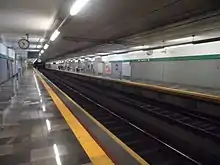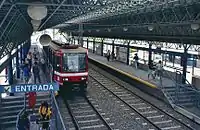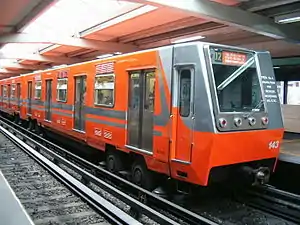Sistema de Tren Eléctrico Urbano
The Sistema de Tren Eléctrico Urbano or SITEUR (lit. 'Urban Electric Train System') is an urban rail transit system serving the Guadalajara metropolitan area, in the municipalities of Guadalajara, Zapopan and Tlaquepaque, in the state of Jalisco, Mexico. It is owned and operated by the state of Jalisco.
| Urban Electric Train System | ||||||||||||||||||||||||||||||||||||||||||||||||||||||||||||||||||||||||||||||||||||||||||||||||||||||||||||||||||||||||||||||||||||||||||||||||||||||||||||||||||||||||||||||||||||||||||||||||||||||||||||||||||||||||||||||||||||||||||||||||
|---|---|---|---|---|---|---|---|---|---|---|---|---|---|---|---|---|---|---|---|---|---|---|---|---|---|---|---|---|---|---|---|---|---|---|---|---|---|---|---|---|---|---|---|---|---|---|---|---|---|---|---|---|---|---|---|---|---|---|---|---|---|---|---|---|---|---|---|---|---|---|---|---|---|---|---|---|---|---|---|---|---|---|---|---|---|---|---|---|---|---|---|---|---|---|---|---|---|---|---|---|---|---|---|---|---|---|---|---|---|---|---|---|---|---|---|---|---|---|---|---|---|---|---|---|---|---|---|---|---|---|---|---|---|---|---|---|---|---|---|---|---|---|---|---|---|---|---|---|---|---|---|---|---|---|---|---|---|---|---|---|---|---|---|---|---|---|---|---|---|---|---|---|---|---|---|---|---|---|---|---|---|---|---|---|---|---|---|---|---|---|---|---|---|---|---|---|---|---|---|---|---|---|---|---|---|---|---|---|---|---|---|---|---|---|---|---|---|---|---|---|---|---|---|---|---|---|---|---|---|---|---|---|---|---|---|---|---|---|---|---|
 | ||||||||||||||||||||||||||||||||||||||||||||||||||||||||||||||||||||||||||||||||||||||||||||||||||||||||||||||||||||||||||||||||||||||||||||||||||||||||||||||||||||||||||||||||||||||||||||||||||||||||||||||||||||||||||||||||||||||||||||||||
 Line 3, the newest line of the SITEUR network | ||||||||||||||||||||||||||||||||||||||||||||||||||||||||||||||||||||||||||||||||||||||||||||||||||||||||||||||||||||||||||||||||||||||||||||||||||||||||||||||||||||||||||||||||||||||||||||||||||||||||||||||||||||||||||||||||||||||||||||||||
| Overview | ||||||||||||||||||||||||||||||||||||||||||||||||||||||||||||||||||||||||||||||||||||||||||||||||||||||||||||||||||||||||||||||||||||||||||||||||||||||||||||||||||||||||||||||||||||||||||||||||||||||||||||||||||||||||||||||||||||||||||||||||
| Native name | Sistema de Tren Eléctrico Urbano | |||||||||||||||||||||||||||||||||||||||||||||||||||||||||||||||||||||||||||||||||||||||||||||||||||||||||||||||||||||||||||||||||||||||||||||||||||||||||||||||||||||||||||||||||||||||||||||||||||||||||||||||||||||||||||||||||||||||||||||||
| Locale | Guadalajara, Jalisco | |||||||||||||||||||||||||||||||||||||||||||||||||||||||||||||||||||||||||||||||||||||||||||||||||||||||||||||||||||||||||||||||||||||||||||||||||||||||||||||||||||||||||||||||||||||||||||||||||||||||||||||||||||||||||||||||||||||||||||||||
| Transit type |
| |||||||||||||||||||||||||||||||||||||||||||||||||||||||||||||||||||||||||||||||||||||||||||||||||||||||||||||||||||||||||||||||||||||||||||||||||||||||||||||||||||||||||||||||||||||||||||||||||||||||||||||||||||||||||||||||||||||||||||||||
| Number of lines | 3 | |||||||||||||||||||||||||||||||||||||||||||||||||||||||||||||||||||||||||||||||||||||||||||||||||||||||||||||||||||||||||||||||||||||||||||||||||||||||||||||||||||||||||||||||||||||||||||||||||||||||||||||||||||||||||||||||||||||||||||||||
| Number of stations | 48 | |||||||||||||||||||||||||||||||||||||||||||||||||||||||||||||||||||||||||||||||||||||||||||||||||||||||||||||||||||||||||||||||||||||||||||||||||||||||||||||||||||||||||||||||||||||||||||||||||||||||||||||||||||||||||||||||||||||||||||||||
| Daily ridership | 240,000[3] | |||||||||||||||||||||||||||||||||||||||||||||||||||||||||||||||||||||||||||||||||||||||||||||||||||||||||||||||||||||||||||||||||||||||||||||||||||||||||||||||||||||||||||||||||||||||||||||||||||||||||||||||||||||||||||||||||||||||||||||||
| Website | SITEUR | |||||||||||||||||||||||||||||||||||||||||||||||||||||||||||||||||||||||||||||||||||||||||||||||||||||||||||||||||||||||||||||||||||||||||||||||||||||||||||||||||||||||||||||||||||||||||||||||||||||||||||||||||||||||||||||||||||||||||||||||
| Operation | ||||||||||||||||||||||||||||||||||||||||||||||||||||||||||||||||||||||||||||||||||||||||||||||||||||||||||||||||||||||||||||||||||||||||||||||||||||||||||||||||||||||||||||||||||||||||||||||||||||||||||||||||||||||||||||||||||||||||||||||||
| Began operation |
| |||||||||||||||||||||||||||||||||||||||||||||||||||||||||||||||||||||||||||||||||||||||||||||||||||||||||||||||||||||||||||||||||||||||||||||||||||||||||||||||||||||||||||||||||||||||||||||||||||||||||||||||||||||||||||||||||||||||||||||||
| Operator(s) | SITEUR, an agency of Jalisco state | |||||||||||||||||||||||||||||||||||||||||||||||||||||||||||||||||||||||||||||||||||||||||||||||||||||||||||||||||||||||||||||||||||||||||||||||||||||||||||||||||||||||||||||||||||||||||||||||||||||||||||||||||||||||||||||||||||||||||||||||
| Technical | ||||||||||||||||||||||||||||||||||||||||||||||||||||||||||||||||||||||||||||||||||||||||||||||||||||||||||||||||||||||||||||||||||||||||||||||||||||||||||||||||||||||||||||||||||||||||||||||||||||||||||||||||||||||||||||||||||||||||||||||||
| System length | 46.5 km (28.9 mi)[4] | |||||||||||||||||||||||||||||||||||||||||||||||||||||||||||||||||||||||||||||||||||||||||||||||||||||||||||||||||||||||||||||||||||||||||||||||||||||||||||||||||||||||||||||||||||||||||||||||||||||||||||||||||||||||||||||||||||||||||||||||
| Track gauge | 1,435 mm (4 ft 8+1⁄2 in) standard gauge | |||||||||||||||||||||||||||||||||||||||||||||||||||||||||||||||||||||||||||||||||||||||||||||||||||||||||||||||||||||||||||||||||||||||||||||||||||||||||||||||||||||||||||||||||||||||||||||||||||||||||||||||||||||||||||||||||||||||||||||||
| Electrification | Overhead line;
| |||||||||||||||||||||||||||||||||||||||||||||||||||||||||||||||||||||||||||||||||||||||||||||||||||||||||||||||||||||||||||||||||||||||||||||||||||||||||||||||||||||||||||||||||||||||||||||||||||||||||||||||||||||||||||||||||||||||||||||||
| ||||||||||||||||||||||||||||||||||||||||||||||||||||||||||||||||||||||||||||||||||||||||||||||||||||||||||||||||||||||||||||||||||||||||||||||||||||||||||||||||||||||||||||||||||||||||||||||||||||||||||||||||||||||||||||||||||||||||||||||||
Opened in 1989, the system consists of three lines: Line 1, running from north to south with 20 stations; Line 2, running from the city center to the east with 10 stations; and Line 3, running from the north-west to south-east with 18 stations. A fourth line is under construction, which will run from the city center to the south of the metropolitan area. It is, by far, the most widely used light rail system in North America.
History
The history of urban trains in Guadalajara dates back to the 19th century, with the first trams pulled by mules, serving a route between the Guadalajara Cathedral and the Templo de la Merced.
In 1974, several houses and streets in the city centre were demolished to make way for a new wide roadway, named Avenida Federalismo; the construction project included a new public-transport tunnel beneath the roadway. Avenida Federalismo (also known as Calzada del Federalismo) replaced what had been C. Moro (but with a much wider right-of-way) and is one of Guadalajara's major thoroughfares. The 6.6-kilometre (4.1 mi) tunnel underneath the avenue was designed for future use by a rail system, but due to a lack of funding at the time, it was served initially by a new trolleybus system, which opened on December 15, 1976.[5] Several years later, work began to convert the trolleybus tunnel and stations for use by a light rail line. The tunnel closed for trolleybuses in early 1988,[6] and the first light rail line, Line 1, opened on September 1, 1989.[5][7] Trolleybus service remained in operation on other routes.

A few years later, Line 2 was constructed, generally running east from the city center; it opened on July 1, 1994.[5][7] Because of the continuing heavy traffic congestion on the city's streets and the large numbers of users of the rail system, there are plans to extend Line 2 to the west.
Line 1 runs underground in the city center, but runs "at grade" north and south of the city center, and its surface sections include several level crossings, protected by crossing gates. The station platforms accommodate trains composed of up to 3 cars. Line 2 is entirely underground except for a non-passenger section at its east end, connecting the last station to the maintenance facility. Its stations are long enough to accommodate trains of up to four cars.
Siemens supplied the system engineering, signaling and telecommunication, power supply, and some components of the vehicles.
Construction of Line 3[8] began at the end of 2014. The 21.45-kilometre (13.33 mi) line includes a 5.35 km long (3.32 mi) underground tunnel, flanked by two elevated segments: 8.65 km (5.37 mi) in the northwest Zapopan section and 7.45 km (4.63 mi) in the southeast Tlaquepaque section; the entire line serves 18 stations, 5 of which are in a tunnel.[9] It crosses the full length of the city running northwest to southeast, from Zapopan in the northwest to Tlaquepaque and Tonalá, in the southeast, through the city center.[10] In addition to the rolling stock, Alstom provided the communication, signalling, and traffic control systems for Line 3,[11] which began operation on September 12, 2020.[12]
In 2018, SITEUR added the Auditorio station to Line 1, which became the new northern terminus, and began lengthening Line 1 station platforms from 60 to 90 m (200 to 300 ft) to accommodate three-car train consists. Partial operation began with three-car trains in March 2019, and the platform extension project is expected to be complete by May 2019; other upgrades to train signaling and control are expected to be complete by July 2020. The TEG-90 fleet was updated with new motors and power converters.[13]
Construction of Line 4 began on May 22, 2022,[14] and the line is estimated to be completed by 2024.[15] Line 4 will run approximately 20 km (12 mi) south from Guadalajara/Tlaquepaque (the northern terminus is at the existing Fray Angélico station, which is the southern terminus of the Mi Macro Calzada BRT service) to Tlajomulco along an existing railroad right-of-way.[12][13]
Lines
| Line | Termini | Length | Stations | Year opened | |
|---|---|---|---|---|---|
| Auditorio | Periférico Sur | 16.3 km (10.1 mi) | 20 | 1989 | |
| Juárez | Tetlán | 8.5 km (5.3 mi) | 10 | 1994 | |
| Central de Autobuses | Arcos de Zapopan | 21.4 km (13.3 mi) | 18 | 2020 | |
| Las Juntas | Tlajomulco Centro | 21.2 km (13.2 mi) | 8 | (2024) | |
Line 1
Line 1 runs from north (North Beltway) to south (South Beltway). It is 16.5 kilometres (10.3 mi) long. Line 1 stations are:
- Auditorio
- Periférico Norte (North Beltway)
- Dermatológico
- Atemajac
- División del Norte
- Ávila Camacho (transfer with Line 3)
- Mezquitán
- Refugio
- Juárez (transfer with Line 2)
- Mexicaltzingo
- Washington
- Santa Filomena
- Unidad Deportiva
- Urdaneta
- 18 de Marzo
- Isla Raza
- Patria
- España
- Santuario Mártires de Cristo Rey
- Periférico Sur (South Beltway)
Line 2
Line 2 runs from downtown (Juárez) to the east (Tetlán), and is 8.8 kilometres (5.5 mi) long. Its stations are:
- Juárez (transfer with Line 1)
- Plaza Universidad (transfer with Line 3)
- San Juan de Dios (transfer with Mi Macro Calzada)
- Belisario Domínguez
- Oblatos
- Cristóbal de Oñate
- San Andrés
- San Jacinto
- La Aurora
- Tetlán
Line 3

Line 3 runs from Zapopan in the northwest to Tlaquepaque and Tonalá in the southeast. It's 21.4 km (13.3 mi) long, and its stations are:
- Arcos de Zapopan
- Periférico Belenes
- Mercado del Mar
- Zapopan Centro
- Plaza Patria
- Circunvalación Country
- Ávila Camacho (Connection with Line 1)
- La Normal
- Santuario
- Guadalajara Centro (Connection with Line 2)
- Independencia
- Plaza de la Bandera
- CUCEI
- Revolución
- Río Nilo
- Tlaquepaque Centro
- Lázaro Cárdenas
- Central de Autobuses
Line 4
Line 4 is planned to run from Guadalajara to the municipality of Tlajomulco. It is expected to be 21.1 km (13.1 mi) long. The planned stations are:
- Las Juntas
- Periférico Sur
- Adolf Horn
- Concepción del Valle
- San Sebastián
- La Fortuna
- Centro Universitario
- Tlajomulco Centro
Fleet
The fleet consists of 78 articulated light rail vehicles,[16] each bi-directional ("double-ended") and powered from overhead lines. They have a top speed of 70 km/h (43 mph). Three of the models are the same general type – only the Barcelona Metro 9000 Series units, which operate on the Line 3, are different – three models were built in Mexico, and one model was built in Spain.
The first 16 TLG-88 (Tren Ligero de Guadalajara, 1988) cars were built by Concarril in Ciudad Sahagún,[5] using propulsion equipment from Melmex (Mitsubishi Electric of Mexico).[17] Another 32 TEG-90 (Tren Eléctrico de Guadalajara, 1990) cars were ordered in 1990 and were manufactured by Bombardier, which acquired Concarril in 1992; the TEG-90 cars were built in the same factory as the earlier batch of TLG-88 cars.[5] The TEG-90 are cosmetically similar to the TLG-88 but use propulsion equipment from Siemens. Both the TLG-88 and TEG-90 are derived from the Stadtbahnwagen B design.[12]
SITEUR ordered 18 Barcelona Metro 9000 Series from Alstom for Line 3 in 2014. The rolling stock for Line 3 uses three-car train consists and are equipped with air conditioning; trains can reach a peak speed of 90 km/h (56 mph).[18][19]
In 2015 SITEUR ordered 12 TEG-15 (Tren Eléctrico de Guadalajara, 2015) cars, also from Bombardier, for Line 1.[20] The TEG-15 is based on the TE-12 design for Servicio de Transportes Eléctricos del Distrito Federal in Mexico City.[21]
| Model | Image | Manufacturer | Year Built | Quantity | Operating Lines |
|---|---|---|---|---|---|
| TLG-88 | .jpg.webp) | Concarril-Melmex (Mitsubishi) | 1988 | 16 | Line 2 |
| TEG-90 |  | Bombardier-Siemens | 1990 | 32 | Lines 1 and 2 |
| TEG-15 |  | Bombardier | 2015 | 12 | Line 1 |
| Barcelona Metro 9000 Series | .jpg.webp) | Alstom | 2016 | 18 | Line 3 |
Gallery
 Line 1 runs at-grade south and north of the city center and has several level crossings.
Line 1 runs at-grade south and north of the city center and has several level crossings. Car 002, built in 1988 by Concarril, laying over at Periférico Sur station, the southern terminus of Line 1, in 1990.
Car 002, built in 1988 by Concarril, laying over at Periférico Sur station, the southern terminus of Line 1, in 1990. Unidad Deportiva station on Line 1 (1990)
Unidad Deportiva station on Line 1 (1990) Guadalajara Centro station of Line 3 in 2020
Guadalajara Centro station of Line 3 in 2020_(cropped).jpg.webp) Central de Autobuses station on Line 3
Central de Autobuses station on Line 3
See also
References
- Webb, Mary, ed. (2011). "Foreword". Jane's Urban Transport Systems 2011-2012. Coulsdon, Surrey: Jane's Information Group. pp. 20–22. ISBN 978-0-7106-2954-8.
- World Systems List: Mexico (with introduction and country index here). 2019. Light Rail Transit Association (UK).
- "Características Tren Eléctrico" [Electric Train Characteristics] (in Spanish). SITEUR. 2013. Archived from the original on July 28, 2013. Retrieved September 12, 2020.
- "Guadalajara Light Rail System". Railway Technology. Retrieved October 7, 2021.
- May, Jack (1994). "Mexico Says Sí to LRT: Light Rail South of the Border". 1994 Light Rail Annual & User's Guide. pp. 5–7. ISSN 0160-6913.
{{cite book}}:|journal=ignored (help) - Aberson, Gert (July–August 1993). "Guadalajara Update". Trolleybus Magazine. National Trolleybus Assn. pp. 87–92. ISSN 0266-7452.
- "Características Tren Eléctrico" [Electric Train Characteristics]. Sistema de Tren Eléctrico Urbano. Archived from the original on December 13, 2014.
- "Line 3".
- "Presentación SITEUR 2019" (PDF) (in Spanish). Sistema de Tren Eléctrico Urbano.
- "Línea 3 del Tren Eléctrico de Guadalajara" (PDF). Línea 3 project website (in Spanish). Secretaría de Comunicaciones y Transportes, Jalisco. 2014. Archived from the original (PDF) on September 4, 2015. Retrieved August 10, 2015.
- "Mexico opens third line of Guadalajara urban transportation network". Railway Technology. September 15, 2020. Retrieved October 7, 2021.
- Castañeda, Roberto (September 2020). "Guadalajara Metro line 3 inaugurated". Urban Transport Magazine. Retrieved October 7, 2021.
- "Perspectivas para el Desarrollo Metro de la Zona Metropolitana Guadalajara" [Prospects for Transit Development of the Guadalajara Metropolitan Area] (PDF) (in Spanish). SITEUR. April 2019. Retrieved October 7, 2021.
- "ENRIQUE ALFARO STARTS THE WORKS OF LINE 4 TO TLAJOMULCO". Jalisco. Jalisco, Mexico. May 22, 2022. Retrieved June 24, 2022.
- Barajas, Diana (September 12, 2021). "Línea 4 con el 90% de avances, según informa Siteur" [Line 4 design 90% complete, according to SITEUR]. Milenio (in Spanish). Retrieved October 7, 2021.
- "SITEUR - Sistema de transport electric urbano" [SITEUR - System of urban electric transport] (in Spanish). SITEUR. 2013. Retrieved July 24, 2013.
- Webb, Mary, ed. (2009). Jane's Urban Transport Systems 2009-2010. Coulson, Surrey: Jane's Information Group. p. 240. ISBN 978-0-7106-2903-6.
- "Alstom delivers the first metro trainset to Guadalajara in Mexico" (Press release). Alstom Mobility. January 25, 2017. Retrieved October 7, 2021.
- "President opens Guadalajara Line 3". Metro Report International. September 14, 2020. Retrieved May 1, 2021.
- "Guadalajara takes delivery of first TEG-15 trainset". Metro Report International. March 21, 2017. Retrieved May 1, 2021.
- "Bombardier Wins Order to Supply Light Rail Vehicles in Guadalajara, Mexico" (Press release). Bombardier Transportation. January 5, 2016. Retrieved October 7, 2021.
External links
- SITEUR (in Spanish)
- Guadalajara at UrbanRail.net
- Mapa del sistema en Google Earth (in English)
